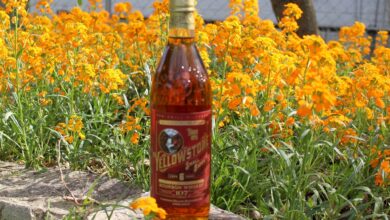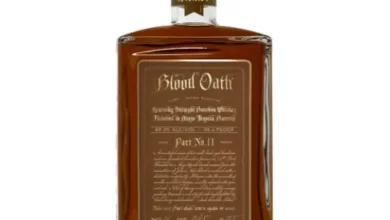Black Bottle Scotch Review
By Richard Thomas
Rating: C+

(Credit: Burns Stewart)
Whiskey history is filled with brand names that were once household words, but the vagueries of time have pushed into the background. Scotch is no exception, but the worldwide whiskey boom has brought some of these survivors out of obscurity, and taken their classic flavor profiles and recipes along with them. Black Bottle Blended Scotch is a perfect example.
Like so many Scotch stories, Black Bottle begins with founders outside the distilling trade. The Graham brothers were tea merchants, who set out in 1879 to get into the blended scotch business by fashioning a quality blend. The latter point was underscored by their packaging, an eye-catching bottle of German-made black glass. World War One compelled the brand to switch to green glass, and for some reason the whisky continued to be bottled in green glass right up until the summer of 2013.
Now a property of Burns Stewart, Black Bottle was relaunched in September 2013 with a blend recipe reminiscent of the original style concocted in 1879. What does that mean? According to Master Distiller Ian MacMillan, Black Bottle had “lost itself to Islay,” and needed to “return to its North East roots.” If the whisky is inspired by a late 19th Century blend, the new bottle design is only somewhat newer, inspired by the 1906 Black Bottle.
The Scotch
Black Bottle’s new look is certainly an improvement, giving it a distinctive and Edwardian character. Perhaps I’m biased, given my preference for the look of old Port wine bottles and my dislike of green glass, but I find the return to the black glass so attractive that I really have to wonder if sticking with green glass isn’t a big part of the reason why Black Bottle didn’t slip from the forefront of blended scotch. The scotch is bottled at 40% abv.
Out of that black bottle, the coloring is a clear orange-amber, quite distinctive from the usual very pale yellow that characterizes so many young blends. In fact, it is a little reminiscent of another Burns Stewart blend, Scottish Leader, although only in its amber leanings.
The nose sits astride where grassy scents meet musty wood, kind of like standing in the doorway of an old shed that has been closed up for a long time on a dewy morning. On the floor of that shed is a damp ash pile, because the nose has a tinge of wet ash to it.
The flavor has a touch of floral sweetness with a little caramel-toffee, plus a dash of pepper, but the big flavor is the wood. The finish left a little ashy aftertaste, with the warmth building over time rather than receding.
Since this is a reasonably priced blend, I tried it with a little ice. The chill pushes the wood down and brings the ash up, so fans of smoky flavors might prefer it that way.
Overall, I take MacMillan’s point about moving away from Islay, but not quite leaving it behind. The smoky side of this blend is restrained, and serves the overall character instead of dominating it. It’s certainly a cut above the typical young, blended, mass market scotch.
The Price
Black Bottle retails for around £18 ($30).


